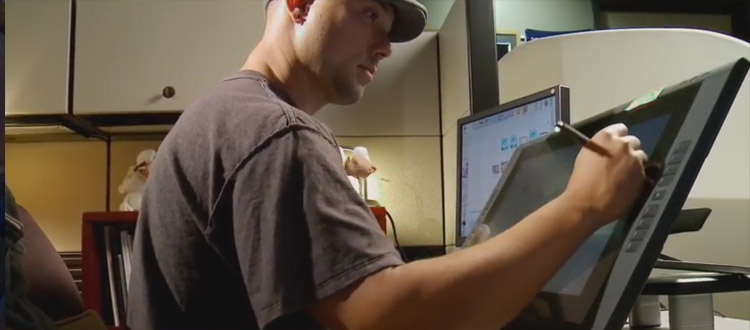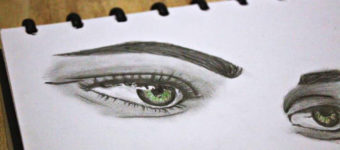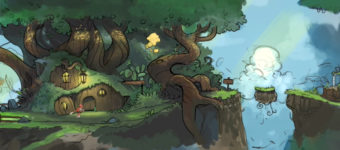
Best Books For Aspiring Visual Development Artists
Thousands of artists want to break into visual development work. It’s a fun job that affords a ton of creativity for artistic direction on movies, TV shows, and video games.
But you need to be damn good to get hired for a visual development role. The job requires a solid understanding of art fundamentals along with color psychology, composition, storytelling, character design, and so much more.
There aren’t any specific vis dev books that focus on all of these topics. But I have collected a bunch of books that will train your eye and your creativity to help you build an eye-catching visual development portfolio and hopefully a career in the field.
Imaginative Realism


James Gurney is a master painter and he knows a lot about creating imaginary art. When you work in vis dev you need to design worlds, characters, creatures, and set the tone for an entire movie/game all from your head.
Gurney’s book Imaginative Realism is a must-own for anyone hoping to break into entertainment art. It has 220+ pages with tons of advice for realist painters and concept artists. These tips apply to all mediums including digital painting and they’re ideas you can take with you onto every project.
The goal is to get you thinking critically about every piece you create. Where is the light source? How would it reflect off an alien’s skin tone? Or how would you design the skeleton of a large humanoid creature?
These are the questions you’ll not only need to ask yourself, but also answer visually in your vis dev work.
I highly recommend this book as a strong starting point for all aspiring vis dev artists regardless of painting background.
Punch Drunk Moustache


This isn’t technically a how-to book but it can teach you how to design your vis dev ideas with clarity and purpose. Punch Drunk Moustache: Visual Development for Animation and Beyond is probably the most complete guide to visual development art.
Over the course of 128 pages you’ll find massive galleries from eight professional vis dev artists. These galleries feature everything from goofy characters to fearsome creatures and everything inbetween.
I look at this as one part portfolio inspiration and another part creative direction.
You’ll find so much in this book that’ll grab your attention and get you thinking about what’s required in the vis dev field. There is a decent amount of writing scattered in here too with tips & advice from pro artists.
Definitely a quality resource for anyone serious about visual development as a career.
The Art of Animal Character Design


David Colman’s The Art of Animal Character Design is a beautiful book to help you design creative yet believable characters.
A lot of animated films and TV shows use animals as main cast members. These come from character designers who need to match the personality, style, tone, and behaviors of the character. This book shows all of the raw creativity that goes into character creation.
In this newer 2nd edition you’ll find three brand new chapters and well over 150+ new images/sketches throughout the book.
Plus David is one amazing artist to learn from since he’s worked with pretty much every animation studio including Disney, Nickelodeon, Cartoon Network, Sony Animation, and so many others.
Visual development goes beyond just character design, but this book covers so much detail that it’s guaranteed to improve your vis dev work & your understanding of the creative process.
The Silver Way


Stephen Silver has worked as a professional artist on many popular shows like Kim Possible and The Fairly OddParents. He knows a lot about the entertainment industry and what types of skills artists need to survive in that area.
The Silver Way: Techniques, Tips, and Tutorials for Effective Character Design is a newer book first released in mid-2017 as a how to guide for aspiring artists. It spans 250 pages with tons of exercises and step-by-step drawing lessons you can follow to improve your character design skills.
Surprisingly these lessons can also apply to professional concept artists & illustrators too. His advice on gesture and cartoon construction are invaluable no matter what level of skill you have.
In many ways this book acts like a complete guide to character design while also dropping more advanced tips into each lesson.
It’s a book you’ll reference many times so it’s well worth adding to your bookshelf.
Note: we did a full review of this book if you wanna learn more & get a peek inside.
Character Mentor


Here’s another character design book written by famous animator Tom Bancroft. He worked on a bunch of Disney films throughout the 90s including The Lion King and Mulan. A lot of his work can be found in the Disney artbooks from these movies too.
But his instruction book Character Mentor also features a ton of his artwork along with step-by-step exercises for aspiring professionals. Tom’s career is primarily animation so his visual development advice leans more towards animated films.
But all character design ideas from games to movies speak to the core of a character’s essence. You can apply these skills to anything from video games to comics or children’s books.
With this book you’ll learn about proper body language and storytelling through visuals.
All great vis dev artists know to use gesture, staging, facial expressions, and color choices to express their ideas clearly. But if you don’t feel your work is up to that level then grab a copy of Tom’s book.
Beyond Art Fundamentals


The team at 3dtotal Publishing have been on a roll with their library of concept art books. One that I highly recommend is Beyond Art Fundamentals that pushes beyond the basics like perspective, form, and lighting.
Instead this book covers the fundamentals of design like mood and emotion in your artwork. Your designs should tell a story with relevant compositions, atmospheres, and narratives that feel believable for your characters.
Both hobbyists and professionals can learn a lot from this book.
It packs 224 pages full of advice together on emotions and expressions in concept art. The later chapters also feature huge artwork galleries from professional artists so you can find a lot of cool ideas too.
Character Design Quarterly


Here’s another title from 3dtotal but this isn’t exactly a book. Character Design Quarterly is a high-end trade magazine for entertainment artists like character designers, concept artists, and visual development artists.
This magazine first launched in late 2017 and has a few great issues so far. It reads just like any other magazine with detailed interviews, industry news, advice for beginners and lots of tutorials for more experienced artists too.
In the first edition you’ll find just over 100 pages with a bunch of guides for great character design. CDQ is one of those magazines you’ll be excited to get in your mailbox every 3 months.
There are a ton of different visual/VFX magazines but none of them really focus on art for the entertainment industry.
3dtotal has been pushing the boundaries on concept art learning materials and this magazine is proof that entertainment art is a rapidly growing industry.
Check out the 3dtotal Publishing website for a bit more info and you can read through our full review of the first issue for a deeper look.
Designing Creatures and Characters


Marc Taro Holmes has over 20 years of professional concept work under his belt. He now works as an art director for games and has dabbled in feature animation too.
He wrote this incredible book Designing Creatures and Characters with the goal of helping artists build a quality portfolio and break into the industry. There’s no denying that visual development is incredibly competitive. Every artist vies for this job and only the best make it through.
This book teaches how to hone your skills and develop a relevant skillset for character design work, creature art, and concept designs, all of which factor into a great vis dev skillset.
Each chapter covers a bunch of lessons that you can follow at home on your own time. Many of these lessons can be repeated dozens of times with different subjects to push yourself outside your comfort zone.
The goal of this book is to help you build relevant skills beyond just sketching and drawing whatever you want. Entertainment art is a job so your portfolio needs to reflect your ability to draw exactly what the studio needs.
If you’re serious about visual development as a career then you’ll want a copy of this book. It is not meant for absolute beginners but it might offer just the right kick in the pants to get beginners practicing a lot more.
Mechanika: Creating the Art of Space, Aliens, Robots and Sci-Fi


Mechanika: Creating the Art of Space, Aliens, Robots and Sci-Fi gets pretty specific into the realm of sci-fi visual development.
The author Doug Chiang actually has a long 25+ year history working on sci-fi films like Terminator 2 and the Star Wars franchise. He shares a bunch of tips for creative direction and techniques for sketching ideas quickly.
And this book even includes 20 different step-by-step exercises you can follow to design space ships, aliens, robots, and tons of other stuff you’ll face in a vis dev career. You’ll learn how to draw inspiration from comics/movies and how to bring those ideas into your work.
Visual development is tough and you’ll always be forced to create ideas that push you into new territory. That’s why I suggest learning sci-fi art even if you hate the genre.
Professional vis dev artists don’t always get to choose their jobs so being versatile makes you far more employable than someone who only covers one genre.
Digital Painting in Photoshop: Sci-fi and Fantasy


Digital Painting in Photoshop: Sci-fi and Fantasy also focuses on sci-fi designs and fantasy environments, but the tutorials specifically teach digital painting with Adobe Photoshop.
If you already have some decent painting skills in PS then this book can take you a lot further. It’ll take your existing knowledge and push you to create more completed projects with set goals & moods.
Industry professionals like Joseba Alexander and Caroline Gariba demonstrate various techniques you can take into all of your vis dev paintings. Environments, vehicles, creatures, characters, every subject gets some attention with guides on many fundamental techniques for digital artists.
While this book does explain some fundamentals like lighting and perspective, it also goes further delving into mood and emotion. Once you understand how this all connects you’ll have an easier time creating work at a professional level.
Absolutely a brilliant guide for vis dev artists who want to beef up their fantasy & sci-fi work.
The Skillful Huntsman


This last book isn’t really a how-to guide or an instructional guide. Instead it’s more like a documented walkthrough following a few visual development students over a large creative project.
The Skillful Huntsman follows three now-professional artists Khang Le, Mike Yamada, and Felix Yoon. They share their thoughts on visual development through a real-world scenario.
Over this 160-page book these three artists complete the task of revamping individual Grimm fairy tale stories and designing vis dev artwork made for TV, movies, and video games. You get to see their entire creative process from start to finish along with the final artwork and how each artist approached the project.
While reading you’ll find a whole bunch of practical tips that’ll stick with you for years to come. Even if you’re just starting to learn how to draw this book will offer endless inspiration and keep you motivated during your practice sessions.
All of these books are fantastic but they only circle around the world of visual development. To become a professional vis dev artist you’ll need a well-rounded skillset and a huge visual library to create almost anything from your head.
But I hope there’s at least something in this collection that can help you keep moving towards your goals. Vis dev is tough but extremely rewarding work.
If you’re truly passionate about art and entertainment then these books will help you edge closer towards breaking into the industry.











